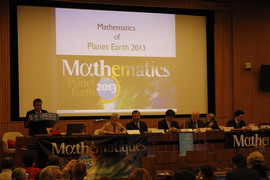The first MPE2013 exhibition featuring the winner modules of the MPE2013 competition held in collaboration with IMAGINARY takes place from March 5 – 8, 2013 at the UNESCO headquarters in Paris.
Earthquakes and Structures
program
Credits
Contributors
Supported by
Every year several earthquakes occur on planet Earth with severe loss of human lives. During an earthquake most of us already experienced the vibrations at the Earth’s surface due to the propagation of the seismic waves along the crust. The main question we intend to answer with this project is: How do the seismic vibrations affect the civil engineering structures like bridges, dams or buildings?
Mathematics is the key to deeply understand the structural dynamic response of structures to seismic base vibrations. The physics of the problem is described mathematically by a differential equation that can be solved for any structure using numerical methods. In the solution of these problems some fundamental numbers arise: they are named natural frequencies and they are intrinsic to each structure (like “finger prints”).
Using the developed interactive program EquakeStruct.exe the users will see the vibration modes of a dam, a bridge and a building. They will see that some problems (resonance effects) can arise when a structure is excited by base vibrations with a frequency that matches some of the natural frequencies. Finally it is shown how a seismic accelerogram can be studied as a sum of harmonic waves whose amplitudes and frequencies should be known.












